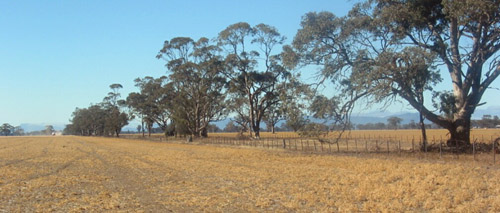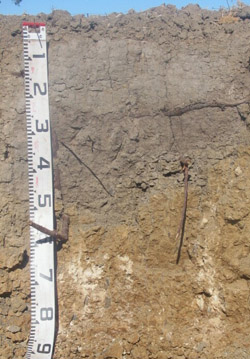TOPCROP5a
Location: Lubeck
Australian Soil Classification: Endocalcareous-Endohypersodic, Epipedal, Grey VERTOSOL
General Landscape Description: Level plain.
Site Description: Cropping paddock (field peas 2002, barley 2001)
Geology: Quaternary (Woorinen Formation) deposits.
 TOPCROP5 Landscape |
Soil Profile Morphology:
Surface Soil
| Ap | 0-5 cm | Dark greyish brown (10YR4/2); light medium clay; surface cracking when dry; moderate medium polyhedral, parting to moderate fine polyhedral structure; strong consistence dry; pH 6.9; clear change to: |  TOPCROP5a Profile |
| Subsoil | |||
| B21 | 5-15/50 cm | Pale brown (10YR6/3) with some sporadic bleaching and rusty root channel mottling; medium clay; moderate very coarse prismatic, parting to moderate coarse blocky structure; strong consistence dry; slight manganese stain; pH 7.3; clear and wavy change to: | |
| B22 | 15/50-70 cm | Light yellowish brown (10YR6/4) with reddish yellow (7.5YR6/8) mottles; heavy clay; moderate very coarse prismatic, parting to moderate coarse blocky structure; strong consistence dry; few (5%) soft calcareous segregations with very few (2%) hard calcareous nodules (5-15 mm); strongly calcareous; pH 9.2: | |
| B23 | 70-90 cm | Reddish yellow (5YR6/8) with light yellowish brown (10YR6/4) mottles; light medium clay; moderate coarse blocky structure; strong consistence dry; very few (2%) soft calcareous segregations; moderately calcareous; pH 9.3. |
Key Profile Features:
- Clay texture throughout the profile.
Soil Profile Characteristics:
| - | pH | Salinity | ||
Surface (A1 horizon) | Slightly Acid | Low-Moderate | Non-Sodic | None1 |
Subsoil (B21 horizon) | Slightly Alkaline | Low-Moderate | Non-Sodic | None |
Deeper Subsoil (at 1 metre) | Very Strongly Alkaline | Moderate | Strongly Sodic | Complete |

| The surface soil is slightly acid. The upper subsoil is slightly alkaline becoming very strongly alkaline with depth. | The salinity rating is low to moderate becoming moderate in the deeper subsoil. | The surface and upper subsoil is non-sodic. The subsoil is strongly sodic. | The boron levels increase in the subsoil. | The clay content is quite high throughout. |
Chemical and Physical Analysis:
Horizon | Horizon Depth (cm) | pH (water) | pH (CaCl2) | EC dS/m | Sodium Chloride % | Exchangeable Cations | |||
Ca | Mg | K | Na | ||||||
meq/100g | |||||||||
Ap | 0-5 | 6.9 | 6.7 | 0.35 | 0.01 | 10 | 4.8 | 1.3 | 0.3 |
B21 | 5-15/50 | 7.3 | 7.0 | 0.43 | <0.01 | 9.4 | 7.9 | 0.7 | 0.6 |
B22 | 15/50-70 | 9.2 | 8.5 | 0.41 | <0.01 | 4.6 | 11 | 0.7 | 3.1 |
B23 | 70-90 | 9.3 | 8.6 | 0.40 | 0.01 | 3.6 | 10 | 0.7 | 3.6 |
Horizon | Horizon Depth (cm) | Boron mg/kg | Total Nitrogen % | Oxidisable Organic Carbon % | Field Capacity pF2.5 | Wilting Point pF4.2 | Coarse Sand (0.2-2.0 mm) % | Fine Sand (0.02-0.2 mm) % | Silt (0.002-0.02 mm) % | Clay (<0.002 mm) % |
Ap | 0-5 | 1.4 | 0.16 | 2.1 | 31.9 | 15.1 | 4 | 40 | 14 | 38 |
B21 | 5-15/50 | 1.4 | 29.8 | 14.5 | 4 | 42 | 8 | 43 | ||
B22 | 15/50-70 | 5 | 32.7 | 16.7 | 3 | 42 | 11 | 38 | ||
B23 | 70-90 | 32.7 | 16.4 | 2 | 42 | 17 | 37 |
Management Considerations:
- In general, management strategies for all soils should aim to increase organic matter levels in the surface soil; minimise the degradation of soil aggregates and porosity; promote the development of stable biopores; improve the calcium status of the ion exchange complex (particularly when sodium is a significant part), and break up any hardpans. Less frequent tillage; using less aggressive implements, and working the soil at optimum moisture conditions can all assist in maintaining soil aggregation and porosity as well as reducing the breakdown of organic matter.
- Tillage of clayey soils like these should be avoided if the soil is wet (i.e. wetter than the plastic limit). At such moisture conditions, excessive tillage, trafficking or over-stocking could result in some structural damage (e.g. compaction). Ideally, tillage should take place on clayey soils when the soil is drier than the plastic limit – down to at least the tillage depth.
- The deeper subsoil is strongly to extremely alkaline. This indicates that phosphorus and some trace elements such as iron, manganese, zinc and copper may be poorly available to plants and deficiencies may occur. Deficiencies can be determined by plant tissue analysis.
- The deeper subsoil becomes strongly sodic and dispersive which will restrict root and water movement at depth in the soil profile.
Profile Described By: Mark Imhof and Brooke Thompson (December 2007).


